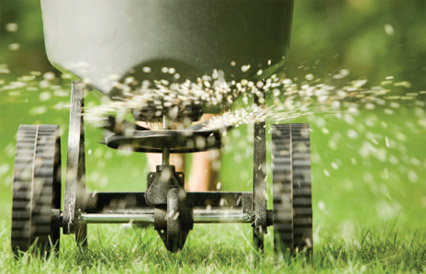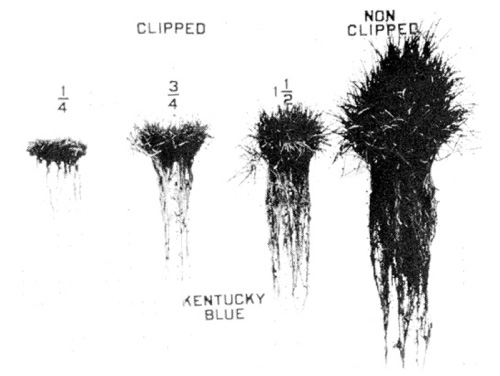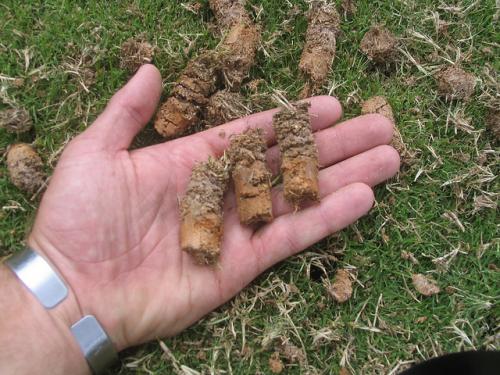Now Is the Time: Fall Lawn Care
By Gretchen Spencer, Fairfax Master Gardener
 Fall is an important transition time for Northern Virginia gardeners to focus on the needs of their lawns. Our lawns are beginning a period of vigorous growth after their long dormant period during the hot summer months. As Master Gardeners, we’ve been taught the mantra: The best defense against weeds and lawn diseases is a healthy and vigorous lawn. Now is the time to take some steps toward maintaining your lawn and preparing it for the winter and spring months ahead.
Fall is an important transition time for Northern Virginia gardeners to focus on the needs of their lawns. Our lawns are beginning a period of vigorous growth after their long dormant period during the hot summer months. As Master Gardeners, we’ve been taught the mantra: The best defense against weeds and lawn diseases is a healthy and vigorous lawn. Now is the time to take some steps toward maintaining your lawn and preparing it for the winter and spring months ahead.
It is important to fertilize your lawn in the fall. Fertilizer builds strong roots, increases the density of the lawn and its drought tolerance, and decreases weed problems and summer diseases. There are three numbers on every bag of fertilizer (such as 12-4-8) that indicate the percent by weight of nitrogen (N), phosphorous (P), and potassium (K). Most established lawns usually need more nitrogen than phosphorous or potassium or may need only nitrogen. Nitrogen is available in two forms–either quickly available (water-soluble) or slowly available (slow-release). Slow-release forms of nitrogen can be applied at higher levels and with less frequency. Applications of up to 1 pound of nitrogen per 1,000 square feet per month of September, October, and November are often recommended. Remember the acronym “SON.”

A higher grass height yields healthier deeper roots
Plan to mow your lawn when needed according to its recommended cutting height. Follow the one-third mowing rule that says you should never remove more than one-third of the leaf blade at any mowing event. This encourages deeper roots and provides more canopy for photosynthesis. Grass roots grow a lot in the fall and winter to establish a good base for spring growth, despite what we see above ground. Leave the grass clippings on the lawn. This provides a natural slow-release fertilizer to the lawn and can contribute about one-third of a lawn’s annual nutrition. Also, don’t forget to service your mower to keep the blades sharp.
If weeds are a problem in your lawn, you can apply any of several pre-emergent herbicides in the fall that will control winter annual weeds such as henbit, chickweed, wild geranium and annual bluegrass that will show up in early spring. There are also many post-emergent herbicides that will control perennial broadleaf weeds such as plantains, dandelions, and clovers that may be applied in the fall. For further information on weed control, you can consult “Lawn Fertilization and Weed Control” on this website or click on one of the links below. Always read and follow directions carefully on the herbicide container.
Overseeding or purchasing sod may be something to think about if you have bare spots or thinning areas in your lawn. Warm day and cool night temperatures in the fall provide the perfect environment for seed germination and establishment of cool-season tall fescues on our lawns. Make sure you select seed varieties adapted to our area. Sod can also be more easily established in the fall. However, do not apply an herbicide if you plan to overseed your lawn because it will prevent germination.
Fall is also a good time to consider doing a soil test, if you think your soil’s nutrients may be the reason for your lawn problems. You can pick up a soil test kit at the Master Gardener Plant Clinic at a local library or at your local Farmers Market. After collecting your soil samples according to the instructions, you can then send them to Virginia Tech for analysis. You will receive information about the fertility of your soil and what steps you need to take to improve it. Most importantly, the test will indicate your soil’s acidity or its pH and recommend whether your soil needs lime, as Virginia’s clay soil becomes acidic naturally. The test lab will also recommend a fertilizer suitable for your lawn. Lawn experts advise doing a soil test every three to four years.
If the soil test results indicate that your lawn needs lime, the best time to apply it is in the fall. You should not apply more than 50 pounds of lime per 1,000 square feet of lawn at any one time. The recommended soil pH for turf grass and most landscape plants is between 5.8 and 6.8, and 6.5 is ideal. A slightly acidic soil is most beneficial to plants since that is when the nutrients are most available. For more information about lime, please refer to Everything a Fairfax Gardener Needs to Know About Lime in this month’s articles.

Aeration for lawns
If you think the soil is your lawn may be too compacted, consider aeration or dethatching. They are best done in the fall so that your lawn can quickly heal from these invasive processes.
Aeration is the process of removing small plugs or cores of soil out of the lawn. If you can push a screwdriver into the soil to three inches (without too much effort), you probably do not need to aerate it. However, aerating the soil is always beneficial, whether it is compacted or not. Aeration is best done with a machine called a core aerator when the soil is moist but not wet. It reduces soil compaction, improves the activity of the microorganisms that live in the soil, and the movement of water, nutrients and oxygen in the soil. Core aerators are easily rentable.
Dethatching, or vertical mowing, removes the thatch, a layer of undecomposed stems and other organic material, that typically develops between the soil and the leaves of grass. You can check the amount of thatch build-up in your lawn by removing a patch of lawn with a shovel and looking at the layer of stems that have built up. A half inch of thatch is not harmful to the lawn. If you have more than a half inch, you can rent a vertical mower to remove the thatch. You can also use a heavy garden rake to loosen dead plant debris and the top of the soil, especially if you plan on overseeding.
If you are interested in a major renovation of your lawn, see our three-part Lawn Renovation series on this website.
Lawn Renovation, Part 1: Making Choices
Let’s Plant New Grass
Lawn Fertilization And Weed Control
As we enter the fall months, take needed steps to “come to the aid of your lawn.” And remember, a healthy, vigorous lawn is your best defense against weeds and lawn diseases.
References
Fall Lawn Care, VCE Publication 430-520
Soil Test Note 17: Lawn Fertilization for Cool Season Grasses, VCE Publication 452-717
Lawn Fertilization in Virginia, VCE Publication CSES-135P
Aerating Your Lawn, VCE Publication 430-002
A Lawn to Dye For-How to Create a Perfect Lawn: Mowing You Lawn, VCE Video CSE-39NP
Soil Test Note 1: Explanation of Soil Tests, VCE Publication 452-701
. . . updated 2022